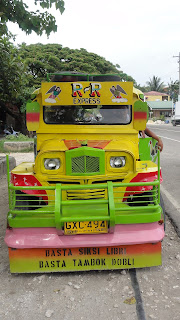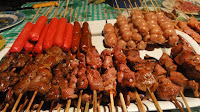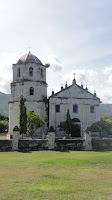Close your eyes (actually don’t, you won’t be able to read
this) and let me take you on an auditory tour of the Philippines. If you were to make a soundtrack of this
country, it would go something like this:
Track 1: Cock-a-doodle-doo (or in Visaya: Tuk-tu-ga-uuk)
The sound of rooster crowing is ubiquitous in the
Philippines. Honestly, at ANY time of
the day or night, no matter where you are, if you listen hard enough you can
hear one. Most of the time you don’t have to listen hard at all, you can hear
it loud and clear without straining your ears one bit. My first week here I was convinced I’d never
sleep due to the persistent rooster crowing that was happening outside my window. One would get going, setting off about 5
others throughout the night. Indeed, I’ve
discovered the concept that roosters only crow at dawn is a MYTH! Luckily I’ve
been able to tune them out now, so while they still crow away, I get more
sleep. Adding to their persistent
crowing is the fact that there are millions of roosters here. Seriously, the rooster should be the national
bird of this country. Roosters are kept
by many household and kept close to home by ankle leashes or small cages. Roosters are also used for cock-fighting
here, but we’ll get into that another time.
Track 2: Karaoke
Almost as pervasive as the crow of a rooster, is the sound of
nearby karaoke. Filippinos
LOVE it and you can hear karaoke being sung at almost any time of day. A little sing-a-long with breakfast?
Sure. Late night, heart-wrenching pop
aria? But of course. The most common karaoke tracks are super
soppy power ballads: Celine, Bon Jovi, Evanescense, Whitney Houston- you get
the picture. Now at home, karaoke is an
activity for drunken goofs belting out YMCA in cheesy bars- where groups get up
and make asses of themselves. Here, it’s
sung by anyone, usually sitting down and very serious. It appears to be as common an activity as going
out for a coffee at home. Karaoke machines can be found in many homes, shop
backrooms, restaurants, and bars. My
favorite thing: the video background they use for tracks. It’s suuuuuper random: film montages of
horses in fields, English countryside scenes, 80s basketball featuring Larry
Bird, and even porn. Very, very
strange.
Track 3: Honk
Our next track is perhaps the most annoying: the incessant
honking of car horns. And truck horns,
bus horns, trike horns…you get the picture.
Every vehicle has a VERY well-used horn.
As a pedestrian in the Philippines, you must get used to hearing one
almost every time any vehicle passes you.
The horn, however, seems to have a different meaning than it does at
home. It’s not usually aggressive like a
horn would be considered in North America.
In fact, I’ve deciphered several meanings for the horn here:
- Honk = “Watch out! I am coming up alongside you. Despite the fact that you are far over on the shoulder and not actually walking on the road, I am concerned that you might randomly hurdle yourself at the last minute in front of my moving vehicle, so I want to let you know I am here. Beware!”
- Honk = “Want a ride? I am a trike/bus/passenger van and can pick you up. No? Sure? Really? You aren’t even facing my way, looking like you want a ride or trying to flag me down, but I better honk another 8 times just to make sure you don’t change your mind.”
- Honk = ‘Hello. Hey there. Hi! Wow, neat, you are a Caucasian walking down the street. Hey, look at me. I want to wave at you. Pay attention.”
- Honk = “This has nothing to do with you. I am a vehicle overtaking another vehicle. Probably on a blind curve and instead of waiting, I am going for it and hoping my honks will alert any speeding oncoming traffic.”
Track 4- Hello, hello, hello, hello
This may seem like a weird one, but I have heard more ‘Hellos’
per day since arriving in Philippines than ever before. Everyone says hello to us. It goes along with the Caucasian novelty
mentioned above (Jagna doesn’t have a big westerner draw most of the time), but
I also think people are just genuinely friendly here (most of the time,
sometimes it’s a repetitive, demanding hello that gets a bit tiresome). The ‘hellos’ come from kids and adults
alike. With kids, they are often
incessant- repeating themselves until you locate where they are shouting from
and say hello back. It’s often then
followed by a lot of giggling. Sometimes
they then ask you your name, proud to show off their English prowess. With older adults, it’s usually just a
singular hello or a ‘good morning’/‘good evening’ depending on the time of
day. With younger adults and teenagers,
it is often followed by a ‘where are you going?’ This is an intriguing question to me since I don’t think I’ve ever asked a stranger where they were going, but
it seems a pretty common here and based in honest curiosity.
We often confuse people by replying ‘home’, which usually elicts a
puzzled response. Sometimes the greetings
directed towards guys are ‘Hey Joe’, an interesting throw back to the
American colonization of the Philippines through the 20th
century. Joe refers to a ‘GI Joe’.
Track 5- Evening music (a call to eat duck fetus)
“Balooooooooooooooooooooooooooot. Balooooooooooooooooooooot.” When the sun goes down, you will begin to
hear this soft chant. What they are
calling out is ‘balut’ but pronounced with a long ‘o’ sound, drawing the word
out almost like a song. Balut is one
Filipino delicacy that I can’t quite wrap my head around. It’s an egg that contains a semi-formed
(16-21 day) duck fetus. It appears to be
consumed mostly in the evening , as this is when you can hear the hawkers call,
and is sold by a guy on a motorbike who pedels the ‘treats’ out of a Styrofoam cooler. Mmmmmmm…duck fetus for dessert. According to my Filipina colleague, it’s
usually consumed while drinking. Which I
guess makes sense, one would probably need to be intoxicated in order to think that
soggy semi-formed baby bird is a tasty treat (and yes, I realize I am not being
very open minded about this, but seriously….)
 |
| A random photo that has nothing to do with the post. |





























































